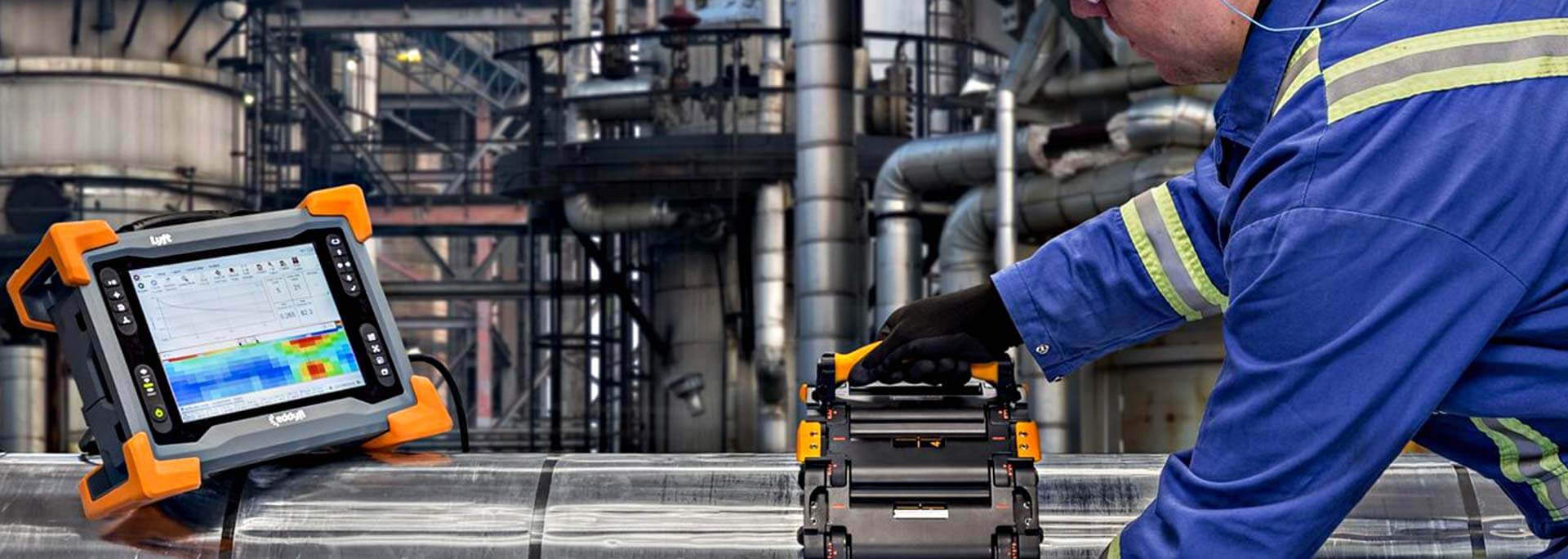
Pulsed Eddy Current
Eddyfi Lyft can scan through thick insulation, as well as aluminum, stainless steel, and galvanized steel weather jackets. It also benefits from a range of PECA, single-element PEC, and application-specific probes to support various applications. Who else but Eddyfi to reinvent an eddy current technique and redefine CUI programs.
Got Lyft
Applications
- Corrosion Under Insulation (CUI)
- Corrosion Under Fireproofing (CUF)
- Insulated pipes and vessels
- Through aluminum, stainless steel, and galvanized steel weather jackets
- In-service scab corrosion assessment, no need to remove the scale
- In-service inspection of storage tank annular plates
- Underwater and splash zone structures
- Marine vessels
Pulsed Eddy Current
The patent-pending high-resolution PECA probe is part of a complete solution dedicated to providing the best estimate of remaining wall thickness over surface-forming scabs and corrosion blisters.
Using an array of dual sensors capable of spatial triangulation, the probe enables the detection of the smallest possible defects with Pulsed Eddy Current (PEC)technology, within an adequate range of wall thickness and liftoff. With 75 mm (3 in) of coverage and encoded dynamic-scanning, typical scabs can be inspected in less than 1 minute! The array design generates clean and compelling C-scans. The novel probe, combined with advanced real-time processing, a dedicated scab mode, and a new scab mat, provides top-quality data at an unrivaled speed. It supports metal thickness 3-19 mm (0.12-0.75 in) and liftoff 0-50 mm (0-2 in).
The groundbreaking PECA probe will make CUI and CUF inspections as much as 10 times faster than with single-element PEC probes! The six-channel array probe can be configured to inspect external diameters from 152 mm (6 in) to flat surfaces. It supports metals 6–25 mm (0.25–1.0 in), insulation 0–102 mm (0–4 in) (fiberglass, plastic wrap, concrete, and any non-ferrous material), and inspections through stainless steel and aluminum weather jackets.
The 6-element PECA probe is capable of a single-pass coverage of 457 mm (18 in) in grid or high-resolution, dynamic mode. The wide coverage not only makes inspections faster than ever but also minimizes inspection preparation with Grid-As-U-Go™. The coverage and accessory dramatically reduce gridding times compared to typical, single-element PEC. Displaying C-scans has never been this fast, improving the overall productivity of inspections as much as 10 times!
Underwater Pulsed Eddy Current (PEC) Probes

Underwater probes can tackle deeper offshore applications. They are watertight down to 100 m (330 ft), can be used, through a long extension cable, with Lyft® in grid-mapping mode. The status LEDs embedded in the probes ensure better control and synchronisation with the topside inspection team. The probes can scan metals as thick as 100 mm (4 in), as well as insulation and marine growth as thick as 300 mm (12 in).
Splash Zone Pulsed Eddy Current (PEC) Probe

The splash zone probe can tackle offshore applications thanks to its rugged design, watertightness to 15 m (49 ft) in grid-mapping mode, and 25 m (82 ft) heavy-duty cable. The probe is flexible enough to support metal thicknesses up to 76 mm (3 in) and insulation or marine growth up to 203 mm (8 in).
Single-element Pulsed Eddy Current (PEC) Probes

The Lyft® solution is compatible with three single-element probes of various sizes for the right balance between wall thickness and liftoff. The single-element probe family offers the flexibility to support metal thicknesses up to 102 mm (3 in), insulation up to 305 mm (12 in) (fiber glass, plastic wrap, concrete, and any non-ferrous material), as well as stainless steel, aluminum, or galvanized steel weather jackets. The probes also offer the capacity to inspect hard-to-reach areas of various geometries. The probes are capable of scanning walls and pipes with diameters as small as 25 mm (1 in). They have a keypad for easy remote operation and can be equipped with a universal clip-on encoder enabling dynamic scans. Accessories include poles (up to 4.6 m/15 ft), extension cables (15 m/50 ft) for rope access, ergonomic clip-on handles and stabilizer, as well as probe shoes for operation on surfaces up to 120°C (248°F) and attenuating vibration from galvanized steel weather jackets.
Tank Floor Pulsed Eddy Current (PEC) Probe

This probe was developed for the in-service inspection of storage tank floor annular rings. Currently, no other inspection technique can do this without emptying tanks. With its super-thin 4.8 mm (0.2 in) titanium blade, the probe can slide up to 400 mm (16 in) under tank floor edges, assessing remaining wall thickness of this critical region exposed to corrosion. The built-in remote controls and status LEDs are designed to enable one-person operation. The tank floor probe’s bottom surface is also magnetically shielded, maximizing sensitivity for optimal component analysis and protection against signal distortion from potential ferromagnetic structures. The probe’s titanium blade is designed to withstand the harshest field conditions.
Pulsed Eddy Current (PEC) Probe for Galvanized Steel Cladding

SurfacePro 3D Advanced 3D Visualization and Reporting Software
SurfacePro 3D is an advanced visualization and reporting software designed to automatically create components and overlay stitched C-scan data. Import Lyft reports, create 3D components, and stitch color maps automatically. Easily import, export, create, and edit report templates. Compile and merge inspection data with associated images, inspection parameters, and defect tables for fast and compelling reporting.

Smart
SurfacePro can use imported Lyft reports to automatically create complex 3D components from inspection setups and then stitch and overlay C-scans maps. The software extracts all the relevant information from setups, such as the part dimensions, scan orientation, offset, and dimensions to present the data appropriately.
Flexible
Easily create and modify 3D models of your components manually with all the associated data attached. The software allows you to import various types of C-scans and easily configure their position on components.







